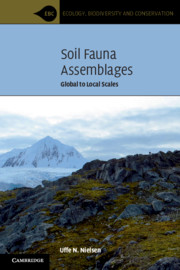Book contents
- Soil Fauna Assemblages
- Ecology, Biodiversity, and Conservation
- Soil Fauna Assemblages
- Copyright page
- Contents
- Preface
- 1 Soil and Its Fauna
- 2 Functional Roles of Soil Fauna
- 3 Approaches to Studying Soil Fauna and Its Functional Roles
- 4 Soil Fauna Biogeography and Macroecology
- 5 Soil Fauna Assemblages at Fine Scales to Landscapes
- 6 Anthropogenic Impacts on Soil Fauna Assemblages
- 7 Climate Change Impacts on Soil Fauna
- 8 Soil Fauna Assemblage Succession and Restoration
- 9 The Future of Soil Fauna Assemblages
- Bibliography
- Index
- References
Bibliography
Published online by Cambridge University Press: 18 March 2019
- Soil Fauna Assemblages
- Ecology, Biodiversity, and Conservation
- Soil Fauna Assemblages
- Copyright page
- Contents
- Preface
- 1 Soil and Its Fauna
- 2 Functional Roles of Soil Fauna
- 3 Approaches to Studying Soil Fauna and Its Functional Roles
- 4 Soil Fauna Biogeography and Macroecology
- 5 Soil Fauna Assemblages at Fine Scales to Landscapes
- 6 Anthropogenic Impacts on Soil Fauna Assemblages
- 7 Climate Change Impacts on Soil Fauna
- 8 Soil Fauna Assemblage Succession and Restoration
- 9 The Future of Soil Fauna Assemblages
- Bibliography
- Index
- References
- Type
- Chapter
- Information
- Soil Fauna AssemblagesGlobal to Local Scales, pp. 291 - 350Publisher: Cambridge University PressPrint publication year: 2019



